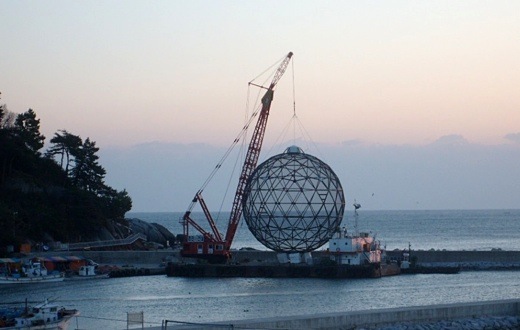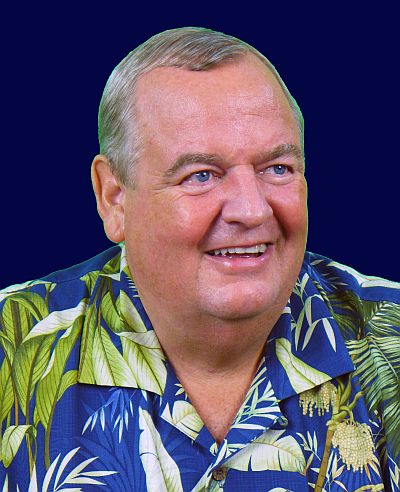SUBHEAD: Here are some sources of alternate opinions on advocacy of raising farmed bluefin tuna.
By Juan Wilson on 6 November 2014 for Island Breath -
(http://islandbreath.blogspot.com/2014/11/farm-tuna-wont-fly.html)

Image above: An aquapod designed by Ocean Farm Technologies being prepared for deployment. From (http://thinkprogress.org/climate/2014/04/21/3422486/big-ag-takes-to-the-ocean/).
Wild tuna are being fished into extinction by modern commercial fishing technology. The increasing demand for the fish is creating increasing competition between Japan, America and other Pacific nations.
It sure would be nice if Hawaii could grow large commercial fish like blue fin and yellow fin tuna in offshore farms? Some think so. The technical problems of raising large predators in densely populated cages are many. To name a few - food sources, waste management and healthcare are complicated and have not been solved in such a way as to be sustainable.
But advocates of tuna fish farming are moving forward in Hawaii. See the article at the bottom of this post that we got Lyn McNutt (http://www.fishupdate.com/sustainably-farmed-tuna-to-become-reality-in-hawaii/). It certainly puts the best face on a business model (farmed seafood) that has proved in most cases to be damaging to the ocean ecosystem and and unhealthy to consumers.
Fish Farm Feed
In general, the feed for farmed fish fall into two categories. For non predators, like tilapia, much of the feed is made up of GMO corn. For carnivorous fish like tuna the feed are small fish that taken in large quantities from wild sea creatures like seabirds, seals and whales.
Fish Farm Fix
The solution is to treat the fish with antibiotics and other medications. The tuna also get supplements like sex hormones to help with procreation in captivity. These chemicals not only affect the farmed tuna but nearby wild fish.
Fish Farm Feces
Farmed fish live in cages. This containment creates a concentrated waste stream that is toxic to the fish that produce it. This impairs the fish and creates health problems. It also pollutes the ocean bottom creatures.
Here are some sources of alternate opinions on advocacy of raising farmed bluefin tuna:
Farm-raised bluefin tuna spawn controversy
(http://www.mnn.com/earth-matters/wilderness-resources/stories/farm-raised-bluefin-tuna-spawn-controversy).
Bluefin Tuna And The Trouble With Fish Farms(http://indianapublicmedia.org/eartheats/bluefin-tuna-trouble-fish-farms/).
Farming The Bluefin Tuna Is Not Without A Price(http://www.npr.org/blogs/thesalt/2014/07/30/336339179/farming-the-bluefin-tuna-tiger-of-the-ocean-is-not-without-a-price)
Farm-Raised Tuna May Not Be the Answer to Overfishing
(http://www.businessweek.com/articles/2013-01-08/farm-raised-tuna-may-not-be-the-answer-to-overfishing)
This does not mean that fish farming cannot be done correctly. PrimeSeaFood.com has said:
Here's the article about tuna fish farming are moving forward in Hawaii.
See also:
Ea O Ka Aina: Governor Wrong on Aquaculture 7/29/11
Ea O Ka Aina: Kauai Shrimp Waste Dump 3/19/10
Ea O Ka Aina: Shrimp Effluent Permit 3/12/10
Island Breath: Something Fishy 7/12/08
Island Breath: Kauai Shrimp to dump in ocean 8/21/06
Island Breath: Kauai's Crustacean Crisis 4/23/04 .
.
By Juan Wilson on 6 November 2014 for Island Breath -
(http://islandbreath.blogspot.com/2014/11/farm-tuna-wont-fly.html)

Image above: An aquapod designed by Ocean Farm Technologies being prepared for deployment. From (http://thinkprogress.org/climate/2014/04/21/3422486/big-ag-takes-to-the-ocean/).
Wild tuna are being fished into extinction by modern commercial fishing technology. The increasing demand for the fish is creating increasing competition between Japan, America and other Pacific nations.
It sure would be nice if Hawaii could grow large commercial fish like blue fin and yellow fin tuna in offshore farms? Some think so. The technical problems of raising large predators in densely populated cages are many. To name a few - food sources, waste management and healthcare are complicated and have not been solved in such a way as to be sustainable.
But advocates of tuna fish farming are moving forward in Hawaii. See the article at the bottom of this post that we got Lyn McNutt (http://www.fishupdate.com/sustainably-farmed-tuna-to-become-reality-in-hawaii/). It certainly puts the best face on a business model (farmed seafood) that has proved in most cases to be damaging to the ocean ecosystem and and unhealthy to consumers.
Fish Farm Feed
In general, the feed for farmed fish fall into two categories. For non predators, like tilapia, much of the feed is made up of GMO corn. For carnivorous fish like tuna the feed are small fish that taken in large quantities from wild sea creatures like seabirds, seals and whales.
Fish Farm Fix
The solution is to treat the fish with antibiotics and other medications. The tuna also get supplements like sex hormones to help with procreation in captivity. These chemicals not only affect the farmed tuna but nearby wild fish.
Fish Farm Feces
Farmed fish live in cages. This containment creates a concentrated waste stream that is toxic to the fish that produce it. This impairs the fish and creates health problems. It also pollutes the ocean bottom creatures.
Here are some sources of alternate opinions on advocacy of raising farmed bluefin tuna:
Farm-raised bluefin tuna spawn controversy
(http://www.mnn.com/earth-matters/wilderness-resources/stories/farm-raised-bluefin-tuna-spawn-controversy).
Bluefin Tuna And The Trouble With Fish Farms(http://indianapublicmedia.org/eartheats/bluefin-tuna-trouble-fish-farms/).
Farming The Bluefin Tuna Is Not Without A Price(http://www.npr.org/blogs/thesalt/2014/07/30/336339179/farming-the-bluefin-tuna-tiger-of-the-ocean-is-not-without-a-price)
Farm-Raised Tuna May Not Be the Answer to Overfishing
(http://www.businessweek.com/articles/2013-01-08/farm-raised-tuna-may-not-be-the-answer-to-overfishing)
This does not mean that fish farming cannot be done correctly. PrimeSeaFood.com has said:
We promote one brand of farm-raised Atlantic salmon, HiddenFjord premium salmon which is raised in the Faroe Islands (between Scotland and Iceland) and one brand of king salmon, Ora King Salmon which is raised in New Zealand.
But most "farmed" salmon can be dangerous to one's health. Just one meal a month can pose a high cancer risk.
For more see (http://www.primeseafood.com/farm_raised_salmon.html)
Here's the article about tuna fish farming are moving forward in Hawaii.
|
See also:
Ea O Ka Aina: Governor Wrong on Aquaculture 7/29/11
Ea O Ka Aina: Kauai Shrimp Waste Dump 3/19/10
Ea O Ka Aina: Shrimp Effluent Permit 3/12/10
Island Breath: Something Fishy 7/12/08
Island Breath: Kauai Shrimp to dump in ocean 8/21/06
Island Breath: Kauai's Crustacean Crisis 4/23/04 .
.

No comments :
Post a Comment